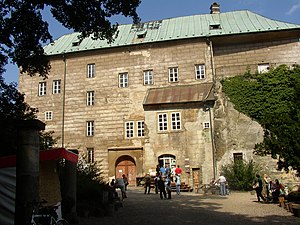Houska Castle
| Houska | ||
|---|---|---|
|
Houska Castle |
||
| Alternative name (s): | Hauska | |
| Creation time : | 2nd half of the 13th century. | |
| Conservation status: | well preserved | |
| Place: | Blatce | |
| Geographical location | 50 ° 29 '27.6 " N , 14 ° 37' 27.2" E | |
| Height: | 410 m nm | |
|
|
||
Houska Castle (German Hauska ) is located in Blatce south of Doksy ( Hirschberg ) in Daubaer Schweiz in the Czech Republic . It stands on a prism-shaped sandstone column. The sgraffito decoration on the facade is typical of Houska .
Building history
From the end of the 9th century on the Schlossberg stood a first wooden, later stone defense system. The foundation is traced back to Prince Slavibor , whose son Housek is said to have given the castle its name. The structure that is preserved today was commissioned by Přemysl Otakar II in 1270–1280 at the same time as the neighboring Bezděz Castle and was probably carried out by the same building works . It belonged to the early Gothic manorial residences, influenced by the Cistercian movement . At the end of the 16th century the castle was rebuilt into a renaissance castle. In 1658 the square tower was demolished and in 1823 the roof was lowered. Further renovations took place in 1924–1939.
description
Houska has a square floor plan with a closed central courtyard. The window shapes have been preserved from the Gothic period. The castle chapel extends over two floors. Gothic and Renaissance murals can be found in the exhibition rooms, and there is an observation tower on the roof. Modern sgraffito decoration is attached to the facade.
In front of the castle there is a Baroque statue of Saint Ludmilla from 1758. On the top of the castle hill there are remains of cellars and the foundations of the church, which was destroyed in 1830. There is also a rock view here. From the upper rooms of the castle itself you can see the surrounding landscape up to Ještěd .
Interior decoration

The chapel and the green chamber are noteworthy . Both rooms kept the Gothic style with wall paintings from 1520. Unique fragments of frescoes from the 13th to 14th centuries have been preserved in the chapel. The hunting salon, the knight's hall , the reconstructed pantry and the ballroom are also interesting .
Ownership
Presumably from the hand of King Wenceslas II (1271–1305) Houska came into the possession of the aristocratic Berka von Dubá family . Further owners were among others in the 15th century Jan Smiřický from the Smiřický von Smiřice family , the Waldstein family , the Counts of Sulz and the Hohenlohe family . In 1924 Josef Šimonek, President of the Škoda Works , which also owned the Stránov Castle , acquired the castle and used it as a summer residence until 1939. In the years 1939-1945 the Wehrmacht confiscated the facility because of its strategically favorable location. In the 1950s the archive of the State Library of the Clementinum was housed in the premises . A planned use as a sanatorium was not realized. Houska has belonged to the descendants of Josef Šimonek since the restitution in the 1990s. The castle was opened to the public for the first time in its history in 1999.
Legend
According to local legend, the entrance to the underworld is under the Houska Castle and the castle was built to cover it up.
Web links
Individual evidence
- ↑ Martina Schneibergová: Stránov Castle: Never besieged and never conquered. In: Radio Praha | in German. January 22, 2011, accessed April 3, 2011.
- ↑ (rer): Screams from below. Locals believe that this castle covers the gate to hell. In: Berliner Zeitung . June 6, 2018, accessed October 8, 2018.

